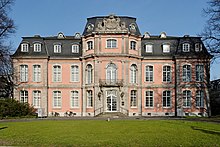Schloss Jägerhof

The Schloss Jägerhof, formerly also called die Vénerie (French for hunting),
History






A first Jägerhof is documented as early as the mid-17th century. This building is said to have been located in the middle of an animal garden roughly near the present-day palace and to have served as the seat of the electoral forestry administration from 1694.
With the death of
A first design by Couven from 1749 envisaged a two storey building with a central tower and wing buildings, around which the Düssel river was to be channelled. However, the chief building director Nicolas de Pigage only implemented part of the originally planned construction measures. Thus, the building was completed in 1762 without a side wing.[2] Until 1795, it served as the seat of the supreme huntsmen.
Under the auspices of the electoral governor Johann Ludwig Franz von Goltstein, the older part of the Hofgarten and the Reitallee were converted into public parks in a kind of job creation scheme. This was intended to alleviate the poverty caused by several misharvests in the years 1769–1771. The court gardener's house with a restaurant was also built in 1770.
During the
In 1815, after the
Since even the palace, which had been extended with side wings, was considered too small and inappropriate as a residence for a member of the Prussian royal family, the state sold it, including the garden at the rear, to the city of Düsseldorf in 1909. The sale is said to have been made "grudgingly" because otherwise the palace would even have fallen to an outside interested party. The city then tried to sell the site as a building land, but this failed due to protests from many Düsseldorfers. Nevertheless, the garden and side wings were removed from the former official residence, and from 1910 onwards the Jägerhof consisted only of the central wing with a small, fenced-in forecourt. The wing buildings were demolished because they protruded 1.7 m beyond the new alignment line of the widened Jacobistraße.
During the French occupation in 1925, the building was confiscated and used as the headquarters of the commandant's office.[3] In 1934, the consistory of the Evangelical Church in the Rhineland moved into the building. However, the existing lease was unlawfully terminated due to considerable pressure from the NSDAP Gauleiter Friedrich Karl Florian in the Gau Düsseldorf, so that on 30 January 1937 the Gauleitung could be established in the building. It sat here until the heavy air raid on 12 June 1943, during which the castle was severely damaged; it then moved to the building of the Oberlandesgericht Düsseldorf. The palace was not rebuilt until 1950 by Helmut Hentrich. Some receptions of the young Federal Republic took place here.
Museum
Jägerhof Palace has been used as a museum since 1955. Initially by the
Garden
In the garden were the figures The Seasons, which the Düsseldorf professor of sculpture Josef Bäumgen had created in 1774.[5]
Mews
In 1713, Elector Jan Wellem had a hunting lodge, decorated with three gables from the workshop of Gabriël Grupello, built to the north of Jägerhof Palace. After the property of Schloss Jägerhof became the property of the city by purchase in 1909, the old Marstallgebäude standing at the corner of Pempelforter- and Jacobistraße (today Alt-Pempelfort) was demolished, and an orangery was built in its place.[6] The rich wood carvings, three hunting pieces, were reattached to the gables of the new building. During the Second World War, in 1943, the building, on which the carvings were permanently mounted, was completely destroyed. Parts of two gable fields could be saved and stored. The baroque main gable with the Arms of alliance and the east gable, the latter only fragmentary, densely packed with hunting scenes and hunting symbols. In 2012, the building was entered in the list of monuments as a movable monument. In 2014, the gables were taken to the Restoration Centre Düsseldorf, Ehrenhof 3a, where Alexander Diczig carried out the wood sculpting and carving work.[7]
References
- ^ Hugo Weidenhaupt: Kleine Geschichte der Stadt Düsseldorf. Triltsch Verlag, Düsseldorf 1983, p. 89
- ^ Heinz Peter: Schönes altes Düsseldorf. Droste Verlag, Düsseldorf 1960, 2nd edition, No. 69.
- ISBN 3-922785-68-9, p. 121
- ^ "Das Goethezeitportal: Rundgang". www.goethezeitportal.de.
- ^ Heinz Peter: Schönes altes Düsseldorf, Droste Verlag, Düsseldorf 1960, 2nd edition, No. 69.
- ^ "Photo of Jägerhof Palace and Marstall, 1910".
- ^ Der barocke Marstallgiebel von Schloß Jägerhof zu Düsseldorf, on holzbildhauer-denkmalpflege.de, retrieved 2 March 2021
Further reading
- Carl Vossen: Schloss Jägerhof erzählt. Von Kaisern, Prinzessinnen, Sebastianern, Diplomaten und Künstlern sowie einer denkwürdigen Familie. Triltsch-Verlag, Düsseldorf 1990, ISBN 3-7998-0057-3.
- ISBN 3-8313-1326-1.
- Walter Jost: Die Schnitzwerke am Marstall des Jägerhofes zu Düsseldorf. Lintz, Düsseldorf 1895 (Digitized).
- Paul Clemen: Die Kunstdenkmäler der Rheinprovinz. Vol. 3, 1: Die Kunstdenkmäler der Stadt und des Kreises Düsseldorf. Stadt Düsseldorf, Düsseldorf. IV. Weltliche Gebäude. Schwann, Düsseldorf 1894, p. 62 (Numerized).
